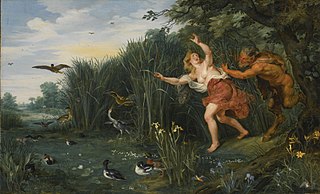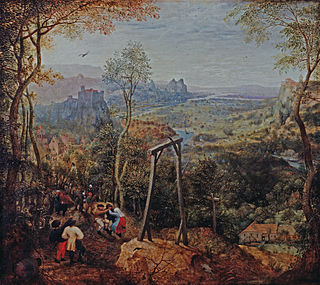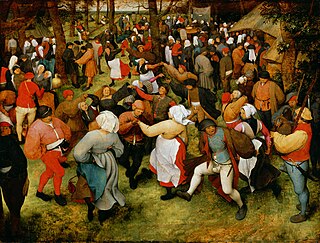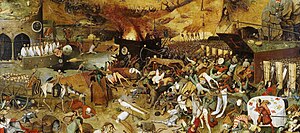
Pieter Bruegelthe Elder was among the most significant artists of Dutch and Flemish Renaissance painting, a painter and printmaker, known for his landscapes and peasant scenes ; he was a pioneer in presenting both types of subject as large paintings.

Jan Brueghelthe Elder was a Flemish painter and draughtsman. He was the son of the eminent Flemish Renaissance painter Pieter Bruegel the Elder. A close friend and frequent collaborator with Peter Paul Rubens, the two artists were the leading Flemish painters in the first three decades of the 17th century.

Jan Brueghelthe Younger was a Flemish Baroque painter. He was the son of Jan Brueghel the Elder, and grandson of Pieter Bruegel the Elder, both prominent painters who contributed respectively to the development of Renaissance and Baroque painting in the Habsburg Netherlands. Taking over his father's workshop at an early age, he largely painted the same subjects as his father in a style which was similar to that of his father. He gradually was able to break away from his father's style by developing a broader, more painterly, and less structured manner of painting. He regularly collaborated with leading Flemish painters of his time.

A skeleton is a type of physically manifested undead often found in fantasy, gothic, and horror fiction, as well as mythology, folklore, and various kinds of art. Most are human skeletons, but they can also be from any creature or race found on Earth or in the fantasy world.

The Harvesters is an oil painting on wood completed by Pieter Bruegel the Elder in 1565. It depicts the harvest time set in a landscape, in the months of July and August or late summer. Nicolaes Jonghelinck, a merchant banker and art collector from Antwerp, commissioned this painting as part of a cycle of six paintings depicting various seasonal transitions during the year.

The Fight Between Carnival and Lent was painted by Pieter Bruegel the Elder in 1559. It is a panorama of contemporary life in the Southern Netherlands. While the painting contains nearly 200 characters, it is unified under the theme of the transition from Shrove Tuesday to Lent, the period forty days before Easter.

Landscape with the Fall of Icarus is a painting in oil on canvas measuring 73.5 by 112 centimetres now in the Royal Museums of Fine Arts of Belgium in Brussels. It was long thought to be by the leading painter of Dutch and Flemish Renaissance painting, Pieter Bruegel the Elder. However, following technical examinations in 1996 of the painting hanging in the Brussels museum, that attribution is regarded as very doubtful, and the painting, perhaps painted in the 1560s, is now usually seen as a good early copy by an unknown artist of Bruegel's lost original, perhaps from about 1558. According to the museum: "It is doubtful the execution is by Bruegel the Elder, but the composition can be said with certainty to be his", although recent technical research has re-opened the question.

The Peasant Wedding is a 1567 genre painting by the Dutch and Flemish Renaissance painter and printmaker Pieter Bruegel the Elder, one of his many depicting peasant life. It is now in the Kunsthistorisches Museum, Vienna. Pieter Bruegel the Elder enjoyed painting peasants and different aspects of their lives in so many of his paintings that he has been called Peasant-Bruegel, but he was an intellectual, and many of his paintings have a symbolic meaning as well as a moral aspect.

Dulle Griet, also known as Mad Meg, is a figure of Flemish folklore who is the subject of a 1563 oil-on-panel by Flemish renaissance artist Pieter Bruegel the Elder. The painting depicts a virago, Dulle Griet, who leads an army of women to pillage Hell, and is currently held and exhibited at the Museum Mayer van den Bergh in Antwerp.

The Magpie on the Gallows is a 1568 oil-on-wood panel painting by the Netherlandish Renaissance artist Pieter Bruegel the Elder. It is now in the Hessisches Landesmuseum in Darmstadt.

Netherlandish Proverbs is a 1559 oil-on-oak-panel painting by Pieter Bruegel the Elder that depicts a scene in which humans and, to a lesser extent, animals and objects, offer literal illustrations of Dutch-language proverbs and idioms.

The Wine of Saint Martin's Day is the largest painting by Pieter Bruegel the Elder. It is currently held in the Museo del Prado, Madrid, where it was identified as a Bruegel original in 2010. Like much of Bruegel's work it depicts peasant life, in this case a festival known as St. Martin's Day, which involves drinking the first wine of the season.

Peeter Baltens, Pieter Balten or Pieter Custodis, was a Flemish Renaissance painter, draughtsman, engraver and publisher. Baltens was also active as an art dealer and poet. He was known for his genre paintings, religious compositions and landscapes.

The Adoration of the Kings is an oil-on-panel painting of the Adoration of the Magi by the Netherlandish Renaissance artist Pieter Bruegel the Elder, painted in 1564, and now in the National Gallery, London.

Storm at Sea is an oil painting on panel by the Netherlandish Renaissance artist Pieter Bruegel the Elder, painted in c. 1569. It is in the Kunsthistorisches Museum in Vienna.

The Procession to Calvary is an oil-on-panel by the Netherlandish Renaissance artist Pieter Bruegel the Elder of Christ carrying the Cross set in a large landscape, painted in 1564. It is in the Kunsthistorisches Museum in Vienna.

The Fall of the Rebel Angels is an oil-on-panel painting of 1562 by the Netherlandish Renaissance artist, Pieter Bruegel the Elder. The painting is 117cm x 162cm and is now in the Royal Museums of Fine Arts of Belgium in Brussels, Belgium. The Fall of Rebel Angels depicts Lucifer along with the other fallen angels that have been banished from heaven. Angels are falling from the sun in a stacked manner along with ungodly creatures that Bruegel created. This piece by Bruegel was previously thought to be by Hieronymus Bosch. Bruegel was influenced by a variety of artists such as Albrecht Dürer, Frans Floris I, and Hieronymus Bosch. He also got ideas for the creation of his creatures in his previous works.

The Wedding Dance is a 1566 oil-on-panel painting by Pieter Bruegel the Elder. Owned by the museum of the Detroit Institute of Arts in Detroit, Michigan, the work was discovered by its director in England in 1930, and brought to Detroit. It is believed to be one of a set of three Bruegel works from around the same time: The Wedding Dance, The Peasant Wedding (1567) and The Peasant Dance (1569).

The Garden of Eden with the Fall of Man or The Earthly Paradise with the Fall of Adam and Eve is a painting by Peter Paul Rubens (figures) and Jan Brueghel the Elder. It is housed in the Mauritshuis art museum in The Hague, Netherlands. The painting depicts the moment just before the consumption of forbidden fruit and the fall of man.

Alpine Landscape is an oil-on-canvas painting by Flemish painter Tobias Verhaecht. The painting was completed between 1600 and 1615, and is now in the Museum of Prado in Madrid.

























